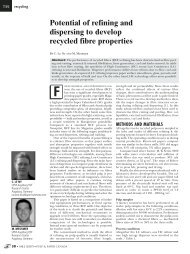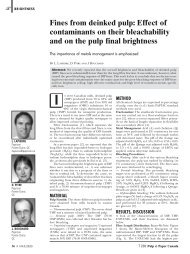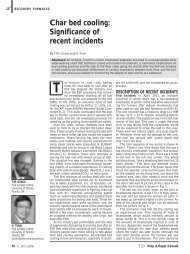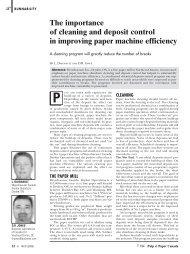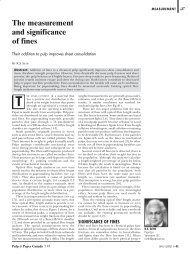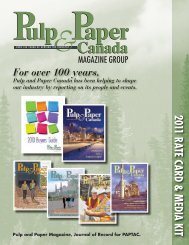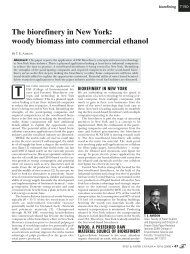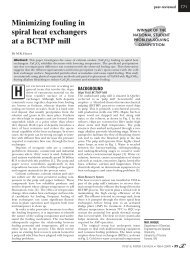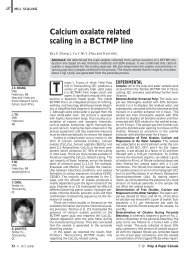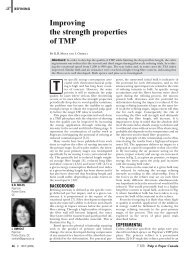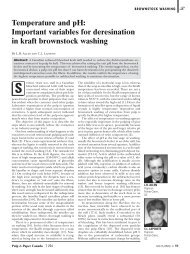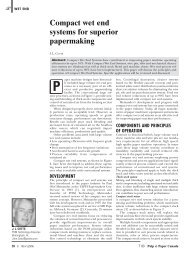Low Consistency Refining of Wood Shavings - Pulp and Paper ...
Low Consistency Refining of Wood Shavings - Pulp and Paper ...
Low Consistency Refining of Wood Shavings - Pulp and Paper ...
Create successful ePaper yourself
Turn your PDF publications into a flip-book with our unique Google optimized e-Paper software.
Mechanical <strong>Pulp</strong>ingT22<strong>Low</strong> <strong>Consistency</strong><strong>Refining</strong> <strong>of</strong><strong>Wood</strong> <strong>Shavings</strong>By T. Kang, G. Soong, J.A. Olson, <strong>and</strong> D.M. MartinezAbstract: This study examines the possibility <strong>of</strong> low consistency (LC) refining <strong>of</strong> wood shavings to replacethe energy intensive high consistency (HC) refining <strong>of</strong> chips. The study demonstrated that LC refining <strong>of</strong>wood shavings required significantly less energy to reach the same freeness <strong>and</strong> paper strength as high consistencyrefining <strong>of</strong> wood chips, but the maximum paper strength <strong>of</strong> LC refined wood shavings was lower.Further advantages <strong>of</strong> using LC refining <strong>of</strong> shavings are increased light scattering coefficient <strong>and</strong> brightness<strong>of</strong> paper.As electrical energy costscontinue to rise with increasingdem<strong>and</strong> <strong>and</strong> with the increasingshortage <strong>of</strong> high quality, long-fibreds<strong>of</strong>twood chips, the future <strong>of</strong> thermo-mechanicalpulping (TMP) using energy-intensive conventional,high consistency disc refiners is far fromcertain. In the last 30 years, since mechanicalpulp strength has been sufficient to completelyreplace kraft pulp in most high quality papergrades, there have been a large number <strong>of</strong> studiesthat have looked at means <strong>of</strong> producing highstrength pulp using lower energy. However, theaverage specific energy used to make mechanicalpulps has typically increased over this time.One strategy <strong>of</strong> reducing energy is theincreased use <strong>of</strong> low consistency (LC) refiners.Conventional TMP chip refining is done at highconsistencies <strong>of</strong> 25% to 40%, while conventionalpost refining is done at various consistenciesranging from 3 % to 40 %, but is most commonlydone at low consistency in the 3-4% range. It iswell known that the LC pulp refining consumesless energy than high consistency (HC) refiningto achieve the same quality change [1-3].As energy costs become higher, LC refiningis gaining more attention as possible means <strong>of</strong>replacing some <strong>of</strong> HC refining energy used in themanufacture <strong>of</strong> high quality papermaking fibres[4-6]. The results <strong>of</strong> these attempts have shownthe reduction <strong>of</strong> energy consumption up to 30%.<strong>Wood</strong> chips are the main raw material inHC mechanical pulping processes, <strong>and</strong> saw millresidues such as sawdust <strong>and</strong> planar shavings canbe mixed with wood chips for the pulping process[7]. Even wood shavings alone can be usedin HC TMP pulping [8], which showed about25 % reduction in refining energy. Initial fibrelength <strong>of</strong> these wood shavings was longer thanthat <strong>of</strong> conventional wood chips, but the finalfibre length <strong>of</strong> wood shavings after HC refiningwere shorter than wood chips.<strong>Wood</strong> shavings are thinner <strong>and</strong> lighter thanwood chips <strong>and</strong> can be fed directly through anLC refiner without HC refining. In effect much<strong>of</strong> the defibering is done in the veneering or shavingprocess. Chemical pretreatment such as sulfonation[9-10] or alkaline peroxide pretreatment(APMP) [11-14] might be needed to s<strong>of</strong>ten thelignin resulting in easier fibre separation duringLC refining, reducing refining energy. APMPseems to be the better pretreatment due to betterpulp quality, sulphur free environment <strong>and</strong> lowerenergy consumption over conventional sulfonation[11, 15].In this research, we explore the use <strong>of</strong> readilyavailable wood materials <strong>and</strong> novel mechanicalpulping methods to complete the initial defibering<strong>of</strong> wood to produce a feed material that issuitable for the more energy efficient LC refiner.The objectives <strong>of</strong> the study were to evaluatewhether wood shavings can be used for LCrefining at the primary stage after chemical pretreatment,<strong>and</strong> to examine the potential energysavings with wood shavings compared to woodchips.methods <strong>and</strong> materialsRaw materialConventional wood chips <strong>and</strong> shavings (85%pine, 10% spruce, 5% fir) were obtained froma pulp mill in the interior <strong>of</strong> British Columbia.Thicknesses <strong>of</strong> wood shavings are approximately0.2 to 0.5 mm, <strong>and</strong> thicknesses <strong>of</strong> wood chips areabout 3 to 5 mm. Fig.1 shows wood shavings <strong>and</strong>wood chips used in the study.T. Kangformerly <strong>Pulp</strong> <strong>and</strong> <strong>Paper</strong>Centre, University <strong>of</strong> BritishColumbia, Vancouver B.C.Now Winstone <strong>Pulp</strong> International.Ohakune, NewZeal<strong>and</strong>G. Soong<strong>Pulp</strong> <strong>and</strong> <strong>Paper</strong> Centre, University<strong>of</strong> British Columbia,Vancouver B.C.J.A. Olson<strong>Pulp</strong> <strong>and</strong> <strong>Paper</strong> Centre, University<strong>of</strong> British Columbia,Vancouver B.C.D.M. Martinez<strong>Pulp</strong> <strong>and</strong> <strong>Paper</strong> Centre, University<strong>of</strong> British Columbia,Vancouver B.C.pulp<strong>and</strong>papercanada.com March/April 2010 <strong>Pulp</strong> & <strong>Paper</strong> Canada 25
T23Mechanical <strong>Pulp</strong>ingtable i. <strong>Pulp</strong> properties.Raw <strong>Refining</strong> Net CSF Fibre Bulk Bauer Bauer Bauermaterial consistency refining (ml) length (cm 3 /g) McNett McNett McNett(%) energy (mm) fractions fractions fractions(kWh/t) (%) (%) (%)R48 R200 P200<strong>Wood</strong> 22% 0 – 2.70 – – – –chips 4163 552 2.10 3.4 68.5 12.2 19.35600 484 2.07 3.1 – – –6297 321 2.03 2.9 66.3 13.7 20.07040 218 1.95 2.5 60.8 14.0 25.2<strong>Wood</strong> 5% 1657 246 1.16 2.9 49.2 30.1 20.7shavings 2520 177 1.10 2.8 50.2 30.0 19.92904 163 1.12 2.8 56.5 26.7 16.9<strong>Wood</strong> 21% 0 – 1.49 – – – –shavings 1148 290 1.07 3.0 49.9 27.6 22.52042 229 1.13 2.9 – – –2852 143 1.14 2.7 45.5 31.7 22.84312 96 1.10 2.4 39.0 30.2 30.8Fig. 1. <strong>Wood</strong> shavings (top) <strong>and</strong> woodchips (bottom). Scale bar <strong>of</strong> 10 mm.Chemical PretreatmentBoth wood chips <strong>and</strong> shavings are separatelyimpregnated with 0.5% diethylenetriaminepentaaceticacid (DTPA) for60 min at 60°C at a consistency <strong>of</strong> 10%.After washing, they were atmosphericallysteamed for 20 min, <strong>and</strong> then they wereimpregnated with 6% sodium hydroxide(NaOH), 4% hydrogen peroxide (H 2O 2),0.05% magnesium sulphate (MgSO 4),1% sodium silicate (Na 2SiO 3) <strong>and</strong> 0.5%DTPA for 60 min at 70°C at a consistency<strong>of</strong> 20%. After chemical pretreatment,the pH was 11.1-11.5. The pretreatedwood shavings <strong>and</strong> wood chips were thendirectly fed through a refiner.<strong>Refining</strong>A Sprout-Waldron 305 mm atmosphericsingle disc refiner (Koppers Co. Inc.,Muncy, USA) equipped with D2A507Ni Hard plates was used for all refiningruns. <strong>Wood</strong> chips <strong>and</strong> wood shavingswere separately refined at 21-22% consistency(referred to as HC refining),<strong>and</strong> the shavings were also refined at 5%consistency (referred to as LC refining).After refining, the pulp discharged fromthe refiner was neutralized with H 2SO 4.MeasurementsThe pulps were hot disintegrated <strong>and</strong>screened on a screen (0.15 mm slots)before pulp testing. All pulp <strong>and</strong> papersamples were tested according to st<strong>and</strong>ardmethods. Fibre length <strong>and</strong> coarseness weremeasured using the fibre quality analyzer(OpTest Equipment, Hawkesbury,Canada). Coarseness measurements <strong>of</strong> themechanical pulp samples were performedon the P14/R28 Bauer McNett fractions.Results <strong>and</strong> discussionThe initial fibre length <strong>of</strong> wood shavingsobtained from the pulp mill is quiteshorter than that from wood chips. This isshown in Fig. 2. A shorter fibre length wasexpected because <strong>of</strong> the smaller dimensions<strong>of</strong> wood shavings. A longer fibrelength <strong>of</strong> wood shavings can be achievedusing a specially designed knife [8, 16],<strong>and</strong> fibres <strong>of</strong> these shavings were deformedhighly without reducing fibre length. Fibrelength <strong>of</strong> HC refined wood chips wasreduced by 22% at a refining energy <strong>of</strong>4163 kWh/t, while that <strong>of</strong> HC refinedwood shavings was reduced by 26% ata refining energy <strong>of</strong> 4312 kWh/t. Thefibre length <strong>of</strong> LC refined wood shavingswas assumed to be similar to that <strong>of</strong> HCrefined wood shavings at a given refiningenergy level. Although the relative initialfibre length <strong>of</strong> wood shavings is shorterin this study, the reduction ratio <strong>of</strong> fibrelength by refining is similar regardless <strong>of</strong>raw materials <strong>and</strong> refining consistency. Ifthe initial fibre length <strong>of</strong> wood shavings islonger or similar to that <strong>of</strong> wood chips, thefinal fibre length may be similar to that <strong>of</strong>wood chips. This implies that a specializedshaving process designed to preserve fibrelength may yield an LC refined pulp withmuch longer fibre length.The freeness <strong>of</strong> both wood shavings<strong>and</strong> wood chips decreased as refiningenergy increased, as shown in Fig. 3 <strong>and</strong>Table I, but at a given freeness, there wasa significant difference in refining energybetween wood shavings <strong>and</strong> wood chips.The freeness <strong>of</strong> HC refined wood shavingsreaches 96 ml at 4312 kWh/t, while that <strong>of</strong>HC refined wood chips reaches to 552 mlat a similar refining energy level. In otherwords, wood chips required more energyto reach the same freeness than woodshavings. A similar response to refining <strong>of</strong>both wood chips <strong>and</strong> wood shavings forHC refining was shown earlier by Viforr& Salmén [8]. For wood shavings, therewas no difference in freeness <strong>and</strong> energyrelationship between LC <strong>and</strong> HC refiningalthough LC refining was expected torequire lower energy than HC refining.Fig. 4 shows the changes in the coarseness<strong>of</strong> the fibre fraction (P14R28) as afunction <strong>of</strong> refining energy. Fibre coarseness<strong>of</strong> both HC <strong>and</strong> LC refined woodshavings is higher in the lower range <strong>of</strong>refining energy, <strong>and</strong> fibre separation fromwood shavings does not seem to be asefficient as wood chips. The reduction <strong>of</strong>coarseness with refining energy is similarfor both LC <strong>and</strong> HC refined wood shavings.A higher coarseness <strong>of</strong> wood shavingswith large middle fractions both fromHC <strong>and</strong> LC refining (Table I) indicatesthat fibre cutting seems to be a dominantmechanism in refining <strong>of</strong> wood shavings,26 <strong>Pulp</strong> & <strong>Paper</strong> Canada March/April 2010 pulp<strong>and</strong>papercanada.com
peer reviewedT24Fig. 2. Fibre length as a function <strong>of</strong> refining energy.Fig. 3. Freeness as a function <strong>of</strong> refining energy.Fig. 4. Coarseness as a function <strong>of</strong> refining energy. P14R28fraction used.which is not an ideal mechanism for fibredevelopment.Tensile strength improvement is proportionalto the refining energy applied.This is shown in Fig. 5. Regardless <strong>of</strong>the differences in refining consistency, allpoints <strong>of</strong> tensile strength <strong>of</strong> wood shavingsare placed almost on the same straight lineas a function <strong>of</strong> refining energy, but thereis a difference in tensile strength improvementbetween wood shavings <strong>and</strong> woodchips. At a given refining energy, tensilestrength <strong>of</strong> wood shavings is higher thanthat <strong>of</strong> wood chips, but the maximumtensile strength <strong>of</strong> wood shavings is limitedprobably due to shorter fibre length. Asimilar trend is seen for tensile stiffness asshown in Fig. 6.Fig. 7 shows that light scattering coefficientfor wood shavings is higher thanwood chips as tensile strength increases.<strong>Refining</strong> <strong>of</strong> both wood chips <strong>and</strong> woodshavings at higher consistency increasesthe light scattering coefficient slowly, whileLC refining <strong>of</strong> wood shavings increaseslight scattering coefficient faster. The differencebetween wood shavings <strong>and</strong> woodchips in HC refining can be explained bythe amount <strong>of</strong> fines <strong>and</strong> middle fractions.The decrease in bulk as shown in Table Ican be the reason for their slower increasein light scattering coefficient. For LCrefined wood shavings, the bulk remainsalmost constant, while the amount <strong>of</strong> theFig. 5. Tensile strength as a function <strong>of</strong> refining energy.Error bars represent the 95% confidence interval.middle fraction is higher than that <strong>of</strong> woodchips.Brightness <strong>of</strong> wood shavings is muchhigher than wood chips as shown inFig. 8. Thinner thickness <strong>of</strong> shavings willlikely be favourable for alkaline peroxidepretreatment. It was shown that chemicalpenetration <strong>and</strong> diffusion rate is a function<strong>of</strong> chip thickness [17-18]. For wood shavings,bleaching efficiency is better for LCrefining. This may be due to more efficientmixing between H 2O 2<strong>and</strong> wood shavingsat lower consistency.Chip dimensions, such as chip thickness,are an important parameter in determiningenergy consumption in refining.More energy is required to fracture a woodpulp<strong>and</strong>papercanada.com March/April 2010 <strong>Pulp</strong> & <strong>Paper</strong> Canada 27
T25Mechanical <strong>Pulp</strong>ingFig. 6. Tensile stiffness as a function <strong>of</strong> refining energy.Error bars represent the 95% confidence interval.Fig. 7. Light scattering coefficient vs. tensile strength.chip with a higher thickness, <strong>and</strong> to refine thicker chips [19-20].The energy consumption for producing wood shavings was foundto be as low as 5 kWh/t while that for wood chips is in the rangebetween 15-25 kWh/t [16].<strong>Wood</strong> shavings have several advantages over conventionalwood chips. Firstly, less energy is required to refine <strong>and</strong> bleachwood shavings having thinner thickness compared to conventionalwood chips. Secondly, fibres deformed during producingwood shavings would improve fibre separation <strong>and</strong> fibre flexibilityduring refining. This preliminary study indicates thatreadily available wood material such as wood shavings used inLC refining has the potential to save both energy <strong>and</strong> bleachingcosts. However, commercially available wood shavings used inthis study have a shorter fibre length, <strong>and</strong> fibre cutting caused byLC refining was inevitable. Fibre length <strong>of</strong> wood shavings can bepreserved using a specially designed knife <strong>and</strong> shaving geometry.Alternative pretreatments such as steam explosion or microwaveor biological treatment should be considered as a means to s<strong>of</strong>tenwood shavings for LC refining. Future work will also look at producingdifferent types <strong>of</strong> wood shavings designed for LC refining.Conclusions<strong>Wood</strong> shavings pretreated with alkaline peroxide were directlyfed through an atmospheric refiner at a consistency <strong>of</strong> 5%. HC<strong>and</strong> LC refining <strong>of</strong> wood shavings showed a better reduction inrefining energy at a given freeness than HC refining <strong>of</strong> woodchips, <strong>and</strong> no difference in the relationship <strong>of</strong> refining energy<strong>and</strong> freeness was found between LC <strong>and</strong> HC refining <strong>of</strong> woodshavings. LC refining <strong>of</strong> wood shavings was found to reduce themean fibre length <strong>of</strong> shavings in a similar ratio with HC refining<strong>of</strong> shavings <strong>and</strong> wood chips. The relatively high coarseness <strong>of</strong>LC refined wood shavings was reduced slightly as a function <strong>of</strong>refining energy.The maximum obtainable tensile strength for LC refinedshavings is lower than that <strong>of</strong> HC refined chips. At a given tensilestrength, lower refining energy was required for LC <strong>and</strong> HCFig. 8. ISO brightness as a function <strong>of</strong> refining energy.refining <strong>of</strong> wood shavings compared to HC refining <strong>of</strong> woodchips. A great advantage <strong>of</strong> using LC refining <strong>of</strong> shavings overwood chips is increased light scattering <strong>and</strong> brightness <strong>of</strong> paper.ACKNOWLEDGEMENTSThis work was funded by the Natural Sciences <strong>and</strong> EngineeringResearch Council <strong>of</strong> Canada through the Collaborative Research<strong>and</strong> Development program <strong>and</strong> through the support <strong>of</strong> our partnersBC Hydro, Paprican, Catalyst <strong>Paper</strong>, Howe Sound <strong>Pulp</strong><strong>and</strong> <strong>Paper</strong>, West Fraser Quesnel River <strong>Pulp</strong>, Canfor, Andritz,Arkema, Honeywell, WestCan Engineering, Advanced FiberTechnologies, Ontario Power Authority <strong>and</strong> CEATI international.LITERATURE1. MUSSELMAN, R, LETARTE, D., SIMARD, R. & LACHANCE, C., Third stagelow consistency refining <strong>of</strong> TMP for newsprint/directory grades, Proc. AppitaConf., p.363-368 (1996).28 <strong>Pulp</strong> & <strong>Paper</strong> Canada March/April 2010 pulp<strong>and</strong>papercanada.com
peer reviewedT262. MUENSTER, H., FERRITSIUS, O., LECOURT, M.& PETIT-CONIL, M., Energy savings in TMP by hightemperature LC/MC refining, Proc. Intl. Mech. <strong>Pulp</strong>.Conf., p.213-223 (2005).3. SABOURIN, M., Minimizing TMP energy consumptionusing a combination <strong>of</strong> chip pre-treatment, RTS<strong>and</strong> multiple stage low consistency refining, Proc. Intl.Mech. <strong>Pulp</strong>. Conf., CD-ROM (2007).4. Hammar, L-Å, Htun, M. & Svensson, B., Atwo-stage refining process to save energy for mechanicalpulps, Proc. Intl. Mech. <strong>Pulp</strong>. Conf., p. 257-262(1997).5. XU, E.C., Koefler, H. & Antensteiner, P.,Some latest developments in alkali peroxide mechanicalpulping, Part 2: <strong>Low</strong> consistency secondary refining,<strong>Pulp</strong> <strong>Paper</strong> Can. 104(10):47-51 (2003).6. Eriksen, O. & Hammar, L-Å., <strong>Refining</strong> mechanisms<strong>and</strong> development <strong>of</strong> TMP properties in a lowconsistencyrefiner, Proc. Intl. Mech. <strong>Pulp</strong>. Conf., p.62-75 (2007).7. Leask, R.A., A potential use <strong>of</strong> a wider range <strong>of</strong>raw material in thermomechanical pulping, Tappi J.60(12):82-87 (1977).8. Viforr, S. & Salmén, L., From wood shavingsto mechanical pulp- a new raw material?, Nord. <strong>Pulp</strong><strong>Paper</strong> Res. J. 20(4):418-422 (2005).9. Atack, A., Heitner, C. & Karnis, A., Ultra-highyield pulping <strong>of</strong> eastern black spruce, Svensk Papperstidn.81(5):133-141 (1980).10. Axelson, P. & Simonson, R., Thermomechanicalpulping with low addition <strong>of</strong> sulfite. Part 1.Effects <strong>of</strong> mild sulfite treatment <strong>of</strong> spruce chips priorto defibration, Svensk Papperstidn. 85(15):R132-R139(1982).11. Bohn, W. & Sferrazza, M., Alkaline peroxidemechanical pulping, a revolution in mechanical pulping,Proc. Intl. Mech. <strong>Pulp</strong>. Conf., p. 184-200 (1989).12. Yuan, Z., Heitner, C. & McGarry, P., Evaluation<strong>of</strong> the APMP process for mature <strong>and</strong> juvenileloblolly pine, Tappi J. 5(7):24-32 (2006).13. Bian, Y., Ni, Y., Yuan, Z, Heitner, C. & Beaulieu,S., Improving TMP rejects refining throughalkaline peroxide pretreatment for value-addedmechanical papers, Tappi J. 6(3):24-32 (2007).14. Zanuttini, M. & Marzocchi, V., Alkalinechemi-mechanical pulp from poplar. Relationshipbetween chemical state, swelling <strong>and</strong> papermakingproperties, Holzforschung. 57(5):489-459 (2003).15. Xu, E.C. & Sabourin, M.J., Evaluation <strong>of</strong> APMP<strong>and</strong> BCTMP for market pulps from South Americaneucalyptus, Tappi J. 82(12):75-82 (1999).16. HEDBLOM-Hue, S., Malm, Å & Salmén, L.,Shear cut chips for mechanical pulping with lowerenergy dem<strong>and</strong>, Proc. Intl. Mech. <strong>Pulp</strong>. Conf., p.143-148 (2001).17. Jimenez, G., Chian, D.S., McKean, W.T. &Gustafson, R.R., Experimental <strong>and</strong> theoreticalstudies to improve pulp uniformity, Proc. TAPPI <strong>Pulp</strong>.Conf., p. 49-53 (1990).18. Svedman, M., Tikka, P. & Luhtanen, M.,Effects <strong>of</strong> s<strong>of</strong>twood morphology <strong>and</strong> chip thicknesson pulping with a displacement kraft batch process,Tappi J. 81(7):157-168 (1998).19. Hoekstra, P.L., Veal, M.A., Lee, P.F. &Sinkey, J.D., The effects <strong>of</strong> chip size on mechanicalpulp properties <strong>and</strong> energy consumption, Tappi J.66(9):119-122 (1983).20. Eskelinen, E., Hu, S.H. & Marton, R.,<strong>Wood</strong> mechanics <strong>and</strong> mechanical pulping, Appita J.36(1):32-38 (1982).Résumé: La présente étude porte sur la possibilité de raffinage à faible concentration (FC) des rabotureset des copeaux au lieu du raffinage haute concentration (HC) des copeaux à forte consommation d’énergie.L’étude a démontré que le raffinage FC des rabotures de bois exigeait beaucoup moins d’énergie pour obtenirle même indice d’égouttage et la même résistance du papier que le raffinage HC des copeaux de bois, mais larésistance maximale du papier fabriqué à partir de rabotures raffinées à faible concentration était moindre. Leraffinage FC concentration des rabotures permet aussi d’améliorer le coefficient de diffusion de la lumière etla blancheur du papier.Reference: KANG, T., SOONG, G., OLSON, J.A., MARTINEZ, D.M. <strong>Low</strong> <strong>Consistency</strong> <strong>Refining</strong><strong>of</strong> <strong>Wood</strong> <strong>Shavings</strong>, <strong>Pulp</strong> & <strong>Paper</strong> Canada 111(2):T22-T26 (Mar/Apr 2010). <strong>Paper</strong> presented atthe 27th International Mechanical <strong>Pulp</strong>ing Conference, Sundsvall, Sweden, June 1-4, 2009. Notto be reproduced without permission <strong>of</strong> PAPTAC. Manuscript received August 31, 2009. Revisedmanuscript approved for publication by the Review Panel November 9, 2009.Keywords: LOW CONSISTENCY REFINING, HIGH CONSISTENCY REFINING, WOOD SHAV-INGS, WOOD CHIPS, ENERGY SAVINGpulp<strong>and</strong>papercanada.com March/April 2010 <strong>Pulp</strong> & <strong>Paper</strong> Canada 29



